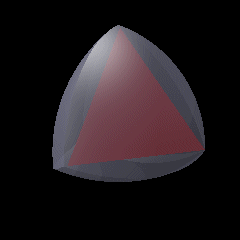Reuleaux tetrahedron


The Reuleaux tetrahedron is the intersection of four spheres of radius s centered at the vertices of a regular tetrahedron with side length s. The sphere through each vertex passes through the other three vertices, which also form vertices of the Reuleaux tetrahedron. The Reuleaux tetrahedron has the same face structure as a regular tetrahedron, but with curved faces: four vertices, and four curved faces, connected by six circular-arc edges.
This shape is defined and named by analogy to the Reuleaux triangle, a two-dimensional curve of constant width; both shapes are named after Franz Reuleaux, a 19th-century German engineer who did pioneering work on ways that machines translate one type of motion into another. One can find repeated claims in the mathematical literature that the Reuleaux tetrahedron is analogously a surface of constant width, but it is not true: the two midpoints of opposite edge arcs are separated by a larger distance,
Volume
The volume of a Reuleaux tetrahedron is [1]
Meissner bodies
Meissner and Schilling[2] showed how to modify the Reuleaux tetrahedron to form a surface of constant width, by replacing three of its edge arcs by curved patches formed as the surfaces of rotation of a circular arc. According to which three edge arcs are replaced (three that have a common vertex or three that form a triangle) there result two noncongruent shapes that are sometimes called Meissner bodies or Meissner tetrahedra.[3] Bonnesen and Fenchel[4] conjectured that Meissner tetrahedra are the minimum-volume three-dimensional shapes of constant width, a conjecture which is still open.[5] In connection with this problem, Campi, Colesanti and Gronchi[6] showed that the minimum volume surface of revolution with constant width is the surface of revolution of a Reuleaux triangle through one of its symmetry axes.
One of Man Ray's paintings, Hamlet, was based on a photograph he took of a Meissner tetrahedron,[7] which he thought of as resembling both Yorick's skull and Ophelia's breast from Shakespeare's Hamlet.[8]
References
- ↑ Weisstein, Eric W (2008), Reuleaux Tetrahedron, MathWorld–A Wolfram Web Resource
- ↑ Meissner, Ernst; Schilling, Friedrich (1912), "Drei Gipsmodelle von Flächen konstanter Breite", Z. Math. Phys., 60: 92–94
- ↑ Weber, Christof (2009). "What does this solid have to do with a ball?" (PDF).
- ↑ Bonnesen, Tommy; Fenchel, Werner (1934), Theorie der konvexen Körper, Springer-Verlag, pp. 127–139
- ↑ Kawohl, Bernd; Weber, Christof (2011), "Meissner's Mysterious Bodies" (PDF), Mathematical Intelligencer, 33 (3): 94–101, doi:10.1007/s00283-011-9239-y
- ↑ Campi, Stefano; Colesanti, Andrea; Gronchi, Paolo (1996), "Minimum problems for volumes of convex bodies", Partial Differential Equations and Applications: Collected Papers in Honor of Carlo Pucci, Lecture Notes in Pure and Applied Mathematics, no. 177, Marcel Dekker, pp. 43–55
- ↑ Swift, Sara (April 20, 2015), "Meaning in Man Ray's Hamlet", Experiment Station, The Phillips Collection.
- ↑ Dorfman, John (March 2015), "Secret Formulas: Shakespeare and higher mathematics meet in Man Ray's late, great series of paintings, Shakespearean Equations", Art & Antiques,
And as for Hamlet, Man Ray himself broke his rule and offered a little commentary: 'The white triangular bulging shape you see in Hamlet reminded me of a white skull”—no doubt referring to the skull of Yorick that Hamlet interrogates in play—“a geometric skull that also looked like Ophelia’s breast. So I added a small pink dot at one of the three corners—a little erotical touch, if you will!'
External links
- Lachand-Robert, Thomas; Oudet, Édouard. "Spheroforms".
- Weber, Christof. "Bodies of Constant Width". There are also films and even interactive pictures of both Meissner bodies.